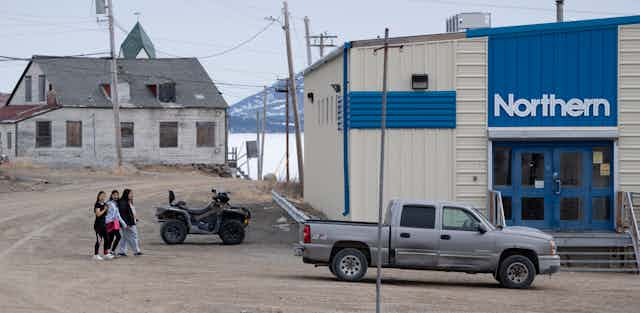As food prices soar it is clear that food security is becoming an ever-growing concern for Canadians. However, not everyone faces these rising costs equally.
In Inuit Nunangat — the homeland of Inuit across Northern Canada — the situation is alarming. In one of the world’s wealthiest nations, a stark 76 per cent of the Inuit population faced food insecurity in 2017, a statistic that has likely grown even worse in the current food price landscape.
Read more: Food insecurity in Canada is the worst it's ever been — here's how we can solve it
The pervasive issue of food insecurity among Inuit, which is closely linked to detrimental nutritional and mental health outcomes, stands out as one of the most enduring and critical public health crises confronting a population within Canada.
But solutions exist that include culturally appropriate food systems to ensure access to affordable, nutritious, safe and preferred foods. Additionally, new research avenues tailored to unique health determinants in the North can inform Inuit-specific actions to prevent disease development linked to diet and food insecurity.
The interdisciplinary program Sentinel North at Université Laval has recently integrated the collective knowledge of its research teams to offer a novel perspective on the links between food security, diet and metabolic health. Integrating the knowledge of different disciplines is crucial to address the multifaceted issue of food insecurity in the North.
Challenges of food security in the Arctic
Food security in the Arctic is multifaceted and is associated with the access, availability, safety and quality of both country food — food that is harvested, hunted, fished, and gathered from the land, rivers, lakes and the sea — and store-bought foods.
At the heart of this complexity are economic dynamics that place strain on Arctic communities. Monetary poverty, amplified by the high cost of living in the Arctic, is one of the main drivers of food insecurity among Inuit. The median individual income for Inuit (15 years and older) in northern Canada is two-thirds that of Canadians as a whole. Meanwhile, the prices for store-bought foods, and other goods and services, can range from double to several times higher than in other parts of the country because of transportation costs.
Compounding these economic constraints are the relentless forces of climate change, which are fundamentally transforming subsistence food systems across the North.

As sea ice recedes, permafrost thaws and extreme weather events increase, accessing traditional hunting and fishing grounds becomes increasingly challenging. Additionally, the abundance and distribution of species, which communities have relied on for generations, are shifting.
But it’s not just climate change that’s a concern.
Read more: A red alert for the future Arctic
The Arctic, despite its remote location, is not isolated from global pollutants. Contaminants from distant regions make their way to the Arctic, carried by atmospheric and oceanic currents. Among these are the “forever chemicals,” a group of persistent compounds that resist environmental degradation and accumulate in the wildlife that communities rely on for sustenance.
While the nutritional and cultural benefits of country foods remain significant, the exposure to these environmental contaminants presents a profound concern for the health and well-being of the Inuit.
These environmental transformations jeopardize both the integrity of the food supply chain and the very traditions that are foundational to the cultural identity of Arctic Indigenous peoples.
The importance of country food
Country foods significantly contribute to the nutrition, health and food security of Inuit communities.

The traditional Inuit diet is notable for its richness in omega-3 fatty acids, largely due to the high consumption of fish and marine-source foods. Recent research has linked fish oil consumption with the proliferation of Akkermansia muciniphila — a gut bacterium heralded for its potential in combating metabolic ailments including obesity, Type 2 diabetes and cardiovascular conditions.
In addition to marine resources, the Arctic offers a bounty of berries, rich in health-promoting polyphenols. Polyphenols act as antioxidants, crucial for neutralizing molecules that can damage cells, promote aging and contribute to various diseases.
Recent research on polyphenolic extracts from cloudberries, alpine bearberries and lingonberries has shown promising outcomes in managing insulin resistance and regulating insulin levels in animal studies. Such findings suggest that regular consumption of these Arctic berries might serve as a culturally appropriate strategy to combat inflammation and associated metabolic disorders.
Beyond being rich sources of essential nutrients, country foods are deeply woven into the fabric of Inuit life, enhancing mental and emotional well-being, fostering community bonds and fortifying cultural heritage. The process of gathering, preparing and sharing country foods is also intertwined with physical activity, mental health and well-being.
Yet, in spite of country food’s integral role, multiple factors — from the enduring impacts of colonization and climate change to socioeconomic challenges, and concerns over environmental contaminants — have accelerated a shift towards a reliance on market foods.

As western dietary patterns gain ground in the Canadian Arctic, health issues such as obesity, diabetes and cardiometabolic disease are on the rise. Developing tailored approaches which consider Inuit lifestyles, genetics and unique dietary traditions are essential to building specialized strategies for mitigating and preventing these rising health concerns.
Culturally adapted food systems
In response to the pressing challenge of food insecurity, northern Indigenous communities across Canada have implemented various food programs.
Community food programs that address acute food insecurity are common. But to ensure resilience, the entire food system needs to be revisited — government policies, programs and monetary investments.
Programs that foster youth knowledge and skills in harvest, that improve community food storage and infrastructure and that allows country food to be provided in an institutional setting are only some examples. For example, a stipend from the city will give nearly 50 daycare children in Iqaluit two meals a day for a year, meals that include country food.
These initiatives not only bolster food security but also champion food sovereignty through community-led and community-driven efforts.
Read more: Arctic Ocean: climate change is flooding the remote north with light – and new species
The journey to resolve food insecurity is complex, with no one-size-fits-all solution. Initiatives that integrate local knowledge and skills with evidence-based research have the potential to forge a sustainable path forward. Mobilizing such research to inform and shape policy is critical, ensuring that the strides made are not just temporary fixes but part of a comprehensive strategy for lasting food security.


